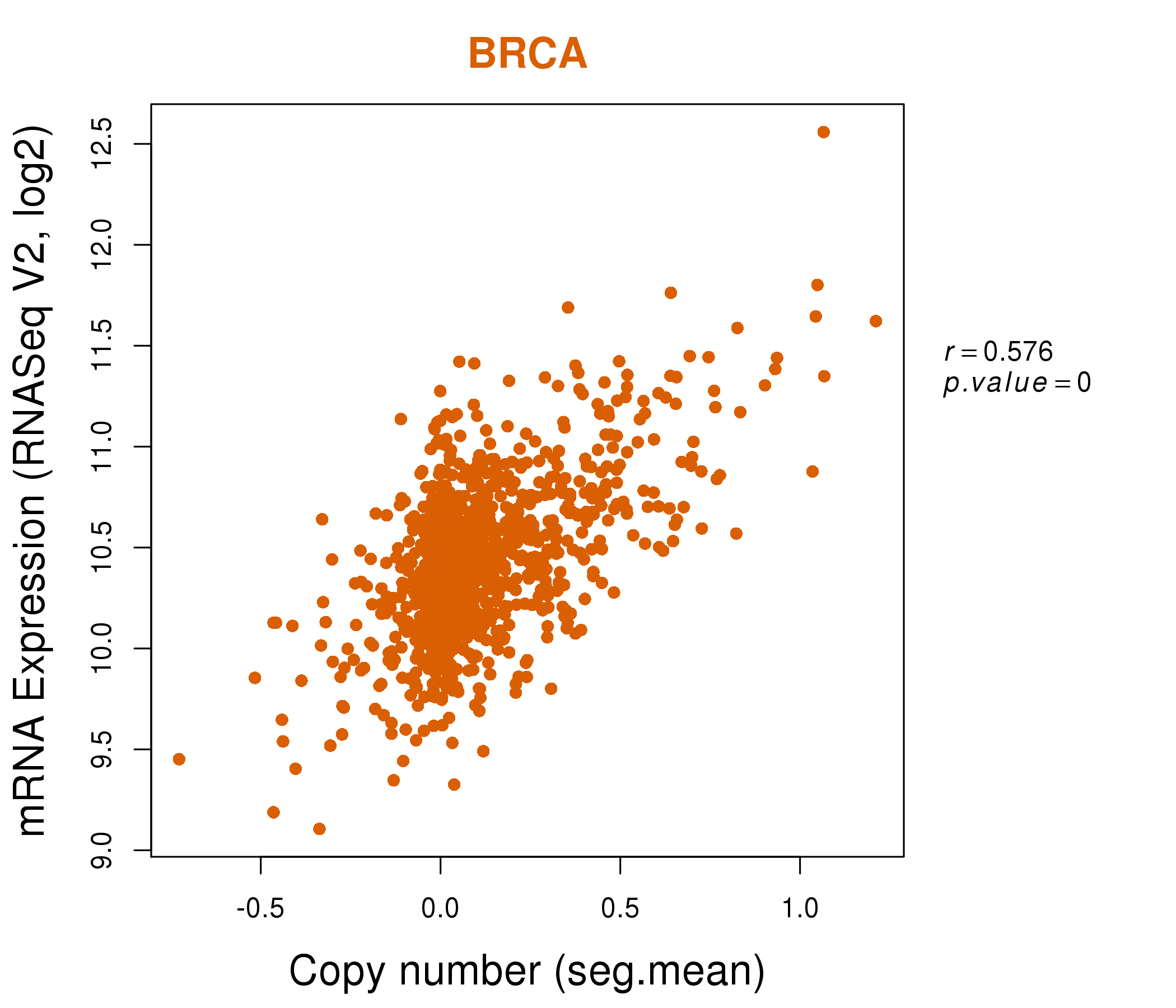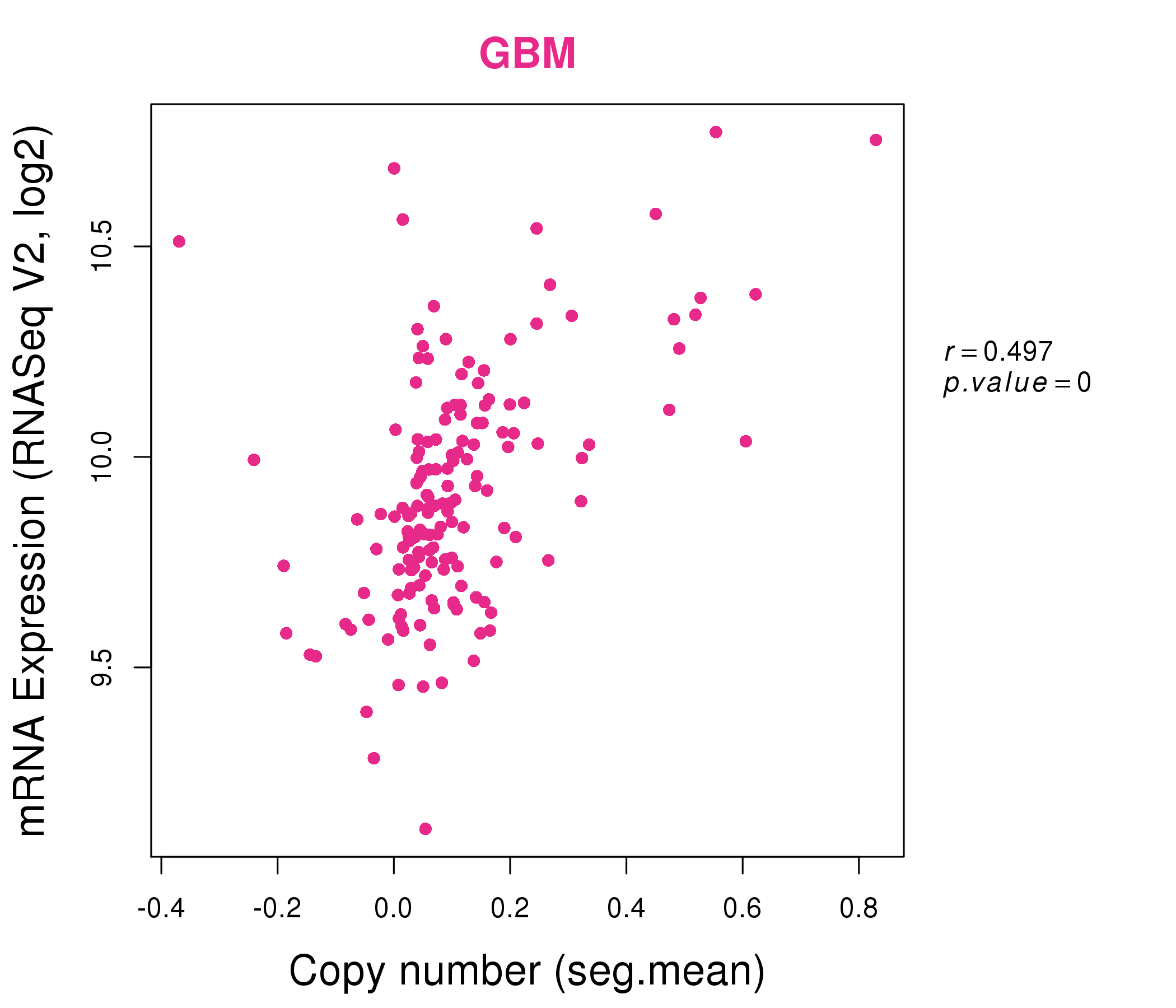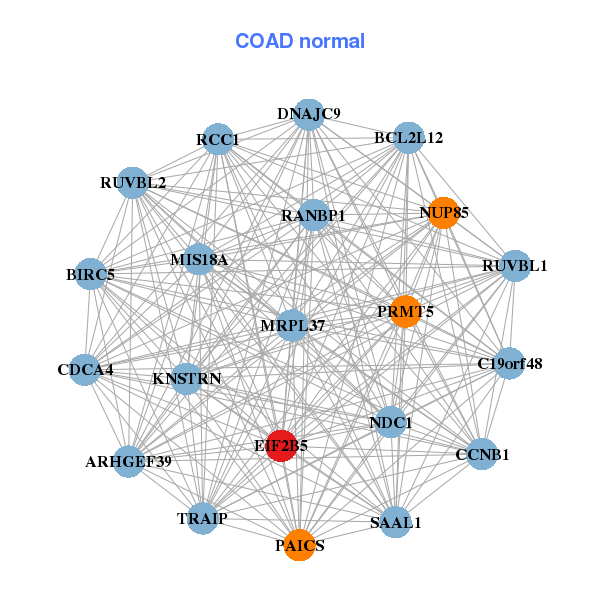|
|||||||||||||||||||||||||||||||||||||||||||||||||||||||||||||||||||||||||||||||||||||||||||||||||||||||||||||||||||||||||||||||||||||||||||||||||||||||||||||||||||||||||||||||||||||||||||||||||||||||||||||||||||||||||||||||||||||||||||||||||||||||||||||||||||||||||||||||||||||||||||||||||||||||||||||||||||||||||||||||||||||||||||||||||||
| |
| Phenotypic Information (metabolism pathway, cancer, disease, phenome) |
| |
| |
| Gene-Gene Network Information: Co-Expression Network, Interacting Genes & KEGG |
| |
|
| Gene Summary for EIF2B5 |
| Basic gene info. | Gene symbol | EIF2B5 |
| Gene name | eukaryotic translation initiation factor 2B, subunit 5 epsilon, 82kDa | |
| Synonyms | CACH|CLE|EIF-2B|EIF2Bepsilon|LVWM | |
| Cytomap | UCSC genome browser: 3q27.1 | |
| Genomic location | chr3 :183852809-183863099 | |
| Type of gene | protein-coding | |
| RefGenes | NM_003907.2, | |
| Ensembl id | ENSG00000145191 | |
| Description | eIF-2B GDP-GTP exchange factor subunit epsilontranslation initiation factor eIF-2B subunit epsilon | |
| Modification date | 20141219 | |
| dbXrefs | MIM : 603945 | |
| HGNC : HGNC | ||
| Ensembl : ENSG00000145191 | ||
| HPRD : 04898 | ||
| Vega : OTTHUMG00000156840 | ||
| Protein | UniProt: Q13144 go to UniProt's Cross Reference DB Table | |
| Expression | CleanEX: HS_EIF2B5 | |
| BioGPS: 8893 | ||
| Gene Expression Atlas: ENSG00000145191 | ||
| The Human Protein Atlas: ENSG00000145191 | ||
| Pathway | NCI Pathway Interaction Database: EIF2B5 | |
| KEGG: EIF2B5 | ||
| REACTOME: EIF2B5 | ||
| ConsensusPathDB | ||
| Pathway Commons: EIF2B5 | ||
| Metabolism | MetaCyc: EIF2B5 | |
| HUMANCyc: EIF2B5 | ||
| Regulation | Ensembl's Regulation: ENSG00000145191 | |
| miRBase: chr3 :183,852,809-183,863,099 | ||
| TargetScan: NM_003907 | ||
| cisRED: ENSG00000145191 | ||
| Context | iHOP: EIF2B5 | |
| cancer metabolism search in PubMed: EIF2B5 | ||
| UCL Cancer Institute: EIF2B5 | ||
| Assigned class in ccmGDB | A - This gene has a literature evidence and it belongs to cancer gene. | |
| References showing role of EIF2B5 in cancer cell metabolism | 1. Sheveleva EV, Landowski TH, Samulitis BK, Bartholomeusz G, Powis G, et al. (2012) Imexon induces an oxidative endoplasmic reticulum stress response in pancreatic cancer cells. Mol Cancer Res 10: 392-400. doi: 10.1158/1541-7786.MCR-11-0359. pmid: 3324333. go to article 2. Xue D, Lu M, Gao B, Qiao X, Zhang Y (2014) Screening for transcription factors and their regulatory small molecules involved in regulating the functions of CL1-5 cancer cells under the effects of macrophage-conditioned medium. Oncol Rep 31: 1323-1333. doi: 10.3892/or.2013.2937. go to article | |
| Top |
| Phenotypic Information for EIF2B5(metabolism pathway, cancer, disease, phenome) |
| Cancer | CGAP: EIF2B5 |
| Familial Cancer Database: EIF2B5 | |
| * This gene is included in those cancer gene databases. |
|
|
|
|
|
| . | |||||||||||||||||||||||||||||||||||||||||||||||||||||||||||||||||||||||||||||||||||||||||||||||||||||||||||||||||||||||||||||||||||||||||||||||||||||||||||||||||||||||||||||||||||||||||||||||||||||||||||||||||||||||||||||||||||||||||||||||||||||||||||||||||||||||||||||||||||||||||||||||||||||||||||||||||||||||||||||||||||||||||||||
Oncogene 1 | Significant driver gene in | ||||||||||||||||||||||||||||||||||||||||||||||||||||||||||||||||||||||||||||||||||||||||||||||||||||||||||||||||||||||||||||||||||||||||||||||||||||||||||||||||||||||||||||||||||||||||||||||||||||||||||||||||||||||||||||||||||||||||||||||||||||||||||||||||||||||||||||||||||||||||||||||||||||||||||||||||||||||||||||||||||||||||||||||||||
| cf) number; DB name 1 Oncogene; http://nar.oxfordjournals.org/content/35/suppl_1/D721.long, 2 Tumor Suppressor gene; https://bioinfo.uth.edu/TSGene/, 3 Cancer Gene Census; http://www.nature.com/nrc/journal/v4/n3/abs/nrc1299.html, 4 CancerGenes; http://nar.oxfordjournals.org/content/35/suppl_1/D721.long, 5 Network of Cancer Gene; http://ncg.kcl.ac.uk/index.php, 1Therapeutic Vulnerabilities in Cancer; http://cbio.mskcc.org/cancergenomics/statius/ |
| REACTOME_METABOLISM_OF_PROTEINS | |
| OMIM | 603896; phenotype. 603945; gene. |
| Orphanet | 157713; Congenital or early infantile CACH syndrome. 157716; Late infantile CACH syndrome. 157719; Juvenile or adult CACH syndrome. 99853; Ovarioleukodystrophy. 99854; Cree leukoencephalopathy. |
| Disease | KEGG Disease: EIF2B5 |
| MedGen: EIF2B5 (Human Medical Genetics with Condition) | |
| ClinVar: EIF2B5 | |
| Phenotype | MGI: EIF2B5 (International Mouse Phenotyping Consortium) |
| PhenomicDB: EIF2B5 | |
| Mutations for EIF2B5 |
| * Under tables are showing count per each tissue to give us broad intuition about tissue specific mutation patterns.You can go to the detailed page for each mutation database's web site. |
| There's no structural variation information in COSMIC data for this gene. |
| * From mRNA Sanger sequences, Chitars2.0 arranged chimeric transcripts. This table shows EIF2B5 related fusion information. |
| ID | Head Gene | Tail Gene | Accession | Gene_a | qStart_a | qEnd_a | Chromosome_a | tStart_a | tEnd_a | Gene_a | qStart_a | qEnd_a | Chromosome_a | tStart_a | tEnd_a |
| BM011896 | EIF2B5 | 132 | 154 | 3 | 183860093 | 183860115 | EIF2B5 | 155 | 705 | 3 | 183858403 | 183860610 | |
| Top |
| Mutation type/ Tissue ID | brca | cns | cerv | endome | haematopo | kidn | Lintest | liver | lung | ns | ovary | pancre | prost | skin | stoma | thyro | urina | |||
| Total # sample | 1 | 1 | ||||||||||||||||||
| GAIN (# sample) | 1 | |||||||||||||||||||
| LOSS (# sample) | 1 |
| cf) Tissue ID; Tissue type (1; Breast, 2; Central_nervous_system, 3; Cervix, 4; Endometrium, 5; Haematopoietic_and_lymphoid_tissue, 6; Kidney, 7; Large_intestine, 8; Liver, 9; Lung, 10; NS, 11; Ovary, 12; Pancreas, 13; Prostate, 14; Skin, 15; Stomach, 16; Thyroid, 17; Urinary_tract) |
| Top |
|
 |
| Top |
| Stat. for Non-Synonymous SNVs (# total SNVs=51) | (# total SNVs=15) |
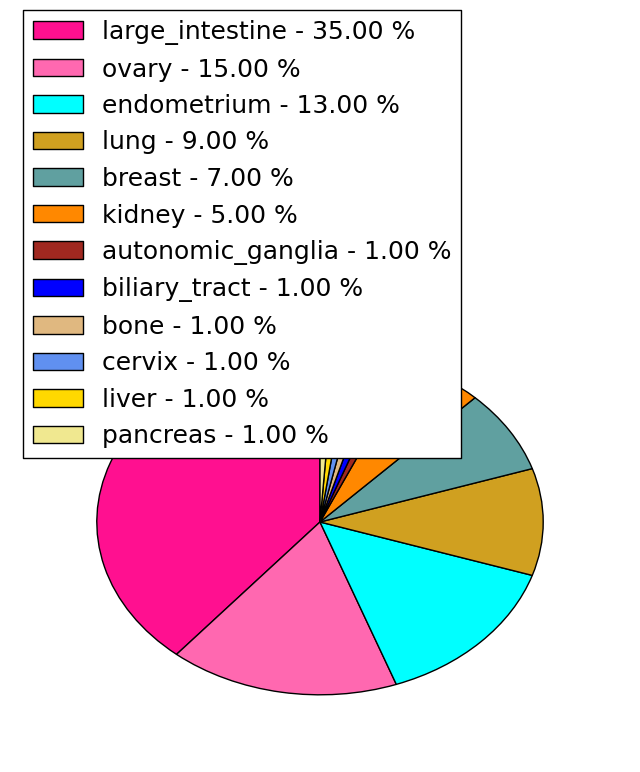 | 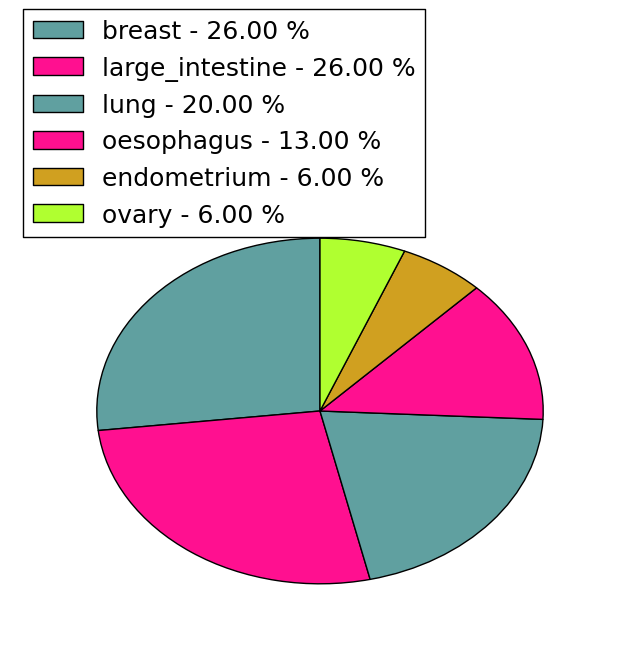 |
(# total SNVs=1) | (# total SNVs=1) |
 | 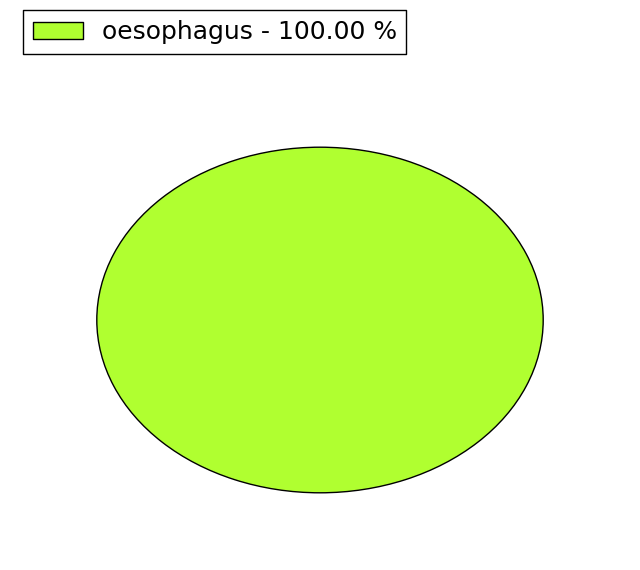 |
| Top |
| * When you move the cursor on each content, you can see more deailed mutation information on the Tooltip. Those are primary_site,primary_histology,mutation(aa),pubmedID. |
| GRCh37 position | Mutation(aa) | Unique sampleID count |
| chr3:183860605-183860605 | p.S529G | 6 |
| chr3:183856022-183856022 | p.I251I | 3 |
| chr3:183855535-183855535 | p.L150L | 2 |
| chr3:183862019-183862019 | p.? | 2 |
| chr3:183858264-183858264 | p.S301F | 2 |
| chr3:183860379-183860379 | p.Q512* | 2 |
| chr3:183859753-183859753 | p.G399G | 2 |
| chr3:183859757-183859757 | p.R401* | 2 |
| chr3:183857942-183857942 | p.E280E | 2 |
| chr3:183860047-183860047 | p.T442M | 2 |
| Top |
|
 |
| Point Mutation/ Tissue ID | 1 | 2 | 3 | 4 | 5 | 6 | 7 | 8 | 9 | 10 | 11 | 12 | 13 | 14 | 15 | 16 | 17 | 18 | 19 | 20 |
| # sample | 1 | 3 | 1 | 17 | 4 | 2 | 1 | 2 | 3 | 6 | 3 | 7 | 1 | 5 | ||||||
| # mutation | 1 | 3 | 1 | 12 | 4 | 2 | 1 | 4 | 3 | 6 | 3 | 8 | 1 | 5 | ||||||
| nonsynonymous SNV | 1 | 1 | 1 | 8 | 2 | 2 | 1 | 3 | 2 | 5 | 1 | 5 | 4 | |||||||
| synonymous SNV | 2 | 4 | 2 | 1 | 1 | 1 | 2 | 3 | 1 | 1 |
| cf) Tissue ID; Tissue type (1; BLCA[Bladder Urothelial Carcinoma], 2; BRCA[Breast invasive carcinoma], 3; CESC[Cervical squamous cell carcinoma and endocervical adenocarcinoma], 4; COAD[Colon adenocarcinoma], 5; GBM[Glioblastoma multiforme], 6; Glioma Low Grade, 7; HNSC[Head and Neck squamous cell carcinoma], 8; KICH[Kidney Chromophobe], 9; KIRC[Kidney renal clear cell carcinoma], 10; KIRP[Kidney renal papillary cell carcinoma], 11; LAML[Acute Myeloid Leukemia], 12; LUAD[Lung adenocarcinoma], 13; LUSC[Lung squamous cell carcinoma], 14; OV[Ovarian serous cystadenocarcinoma ], 15; PAAD[Pancreatic adenocarcinoma], 16; PRAD[Prostate adenocarcinoma], 17; SKCM[Skin Cutaneous Melanoma], 18:STAD[Stomach adenocarcinoma], 19:THCA[Thyroid carcinoma], 20:UCEC[Uterine Corpus Endometrial Carcinoma]) |
| Top |
| * We represented just top 10 SNVs. When you move the cursor on each content, you can see more deailed mutation information on the Tooltip. Those are primary_site, primary_histology, mutation(aa), pubmedID. |
| Genomic Position | Mutation(aa) | Unique sampleID count |
| chr3:183860605 | p.S529G | 6 |
| chr3:183858264 | p.I251I | 2 |
| chr3:183856022 | p.E280E | 2 |
| chr3:183857942 | p.S301C | 2 |
| chr3:183855722 | p.D236N | 1 |
| chr3:183860567 | p.T375T | 1 |
| chr3:183858257 | p.S529S | 1 |
| chr3:183861986 | p.R241Q | 1 |
| chr3:183859720 | p.D387N | 1 |
| chr3:183855751 | p.V557I | 1 |
| * Copy number data were extracted from TCGA using R package TCGA-Assembler. The URLs of all public data files on TCGA DCC data server were gathered on Jan-05-2015. Function ProcessCNAData in TCGA-Assembler package was used to obtain gene-level copy number value which is calculated as the average copy number of the genomic region of a gene. |
 |
| cf) Tissue ID[Tissue type]: BLCA[Bladder Urothelial Carcinoma], BRCA[Breast invasive carcinoma], CESC[Cervical squamous cell carcinoma and endocervical adenocarcinoma], COAD[Colon adenocarcinoma], GBM[Glioblastoma multiforme], Glioma Low Grade, HNSC[Head and Neck squamous cell carcinoma], KICH[Kidney Chromophobe], KIRC[Kidney renal clear cell carcinoma], KIRP[Kidney renal papillary cell carcinoma], LAML[Acute Myeloid Leukemia], LUAD[Lung adenocarcinoma], LUSC[Lung squamous cell carcinoma], OV[Ovarian serous cystadenocarcinoma ], PAAD[Pancreatic adenocarcinoma], PRAD[Prostate adenocarcinoma], SKCM[Skin Cutaneous Melanoma], STAD[Stomach adenocarcinoma], THCA[Thyroid carcinoma], UCEC[Uterine Corpus Endometrial Carcinoma] |
| Top |
| Gene Expression for EIF2B5 |
| * CCLE gene expression data were extracted from CCLE_Expression_Entrez_2012-10-18.res: Gene-centric RMA-normalized mRNA expression data. |
 |
| * Normalized gene expression data of RNASeqV2 was extracted from TCGA using R package TCGA-Assembler. The URLs of all public data files on TCGA DCC data server were gathered at Jan-05-2015. Only eight cancer types have enough normal control samples for differential expression analysis. (t test, adjusted p<0.05 (using Benjamini-Hochberg FDR)) |
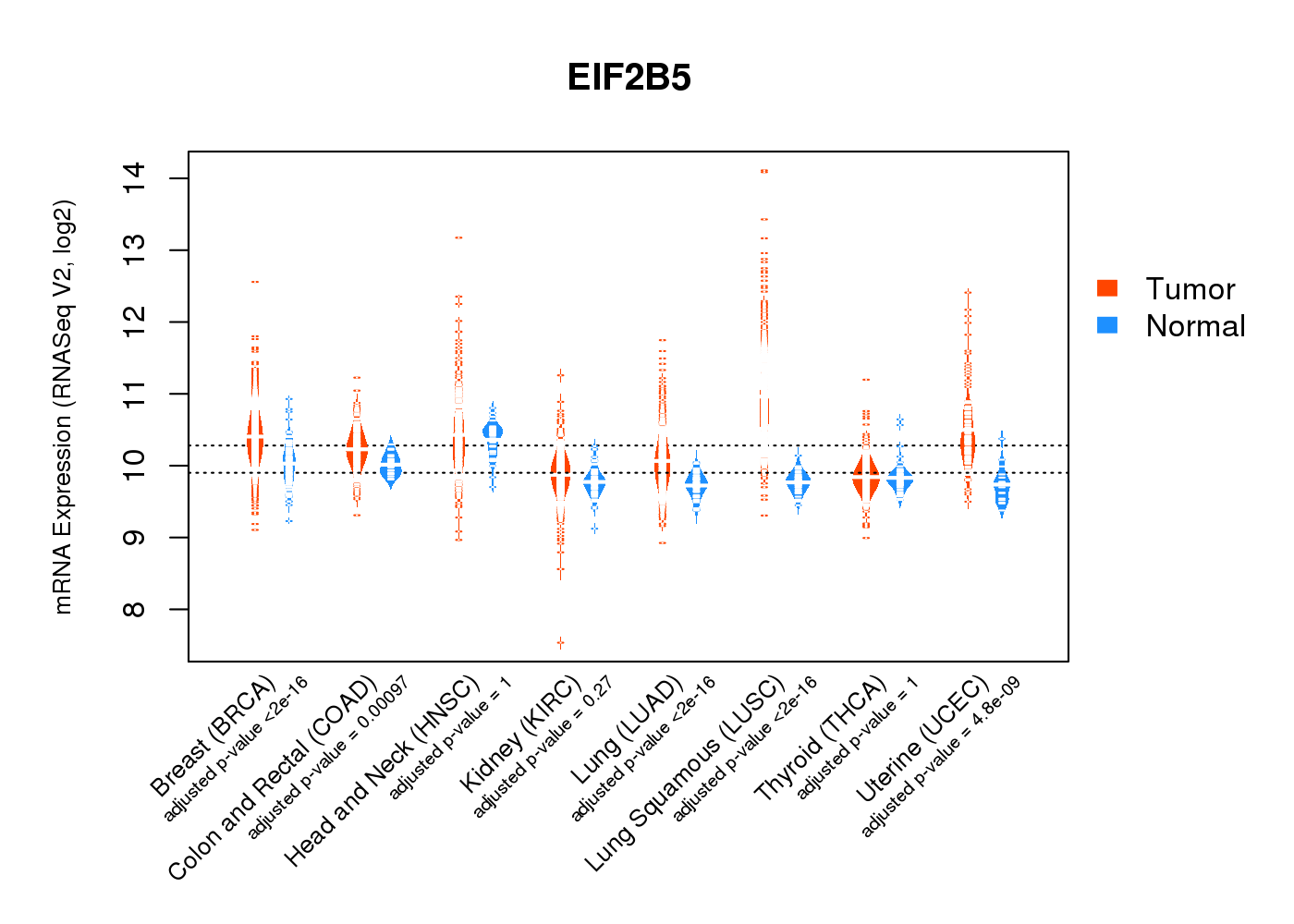 |
| Top |
| * This plots show the correlation between CNV and gene expression. |
: Open all plots for all cancer types
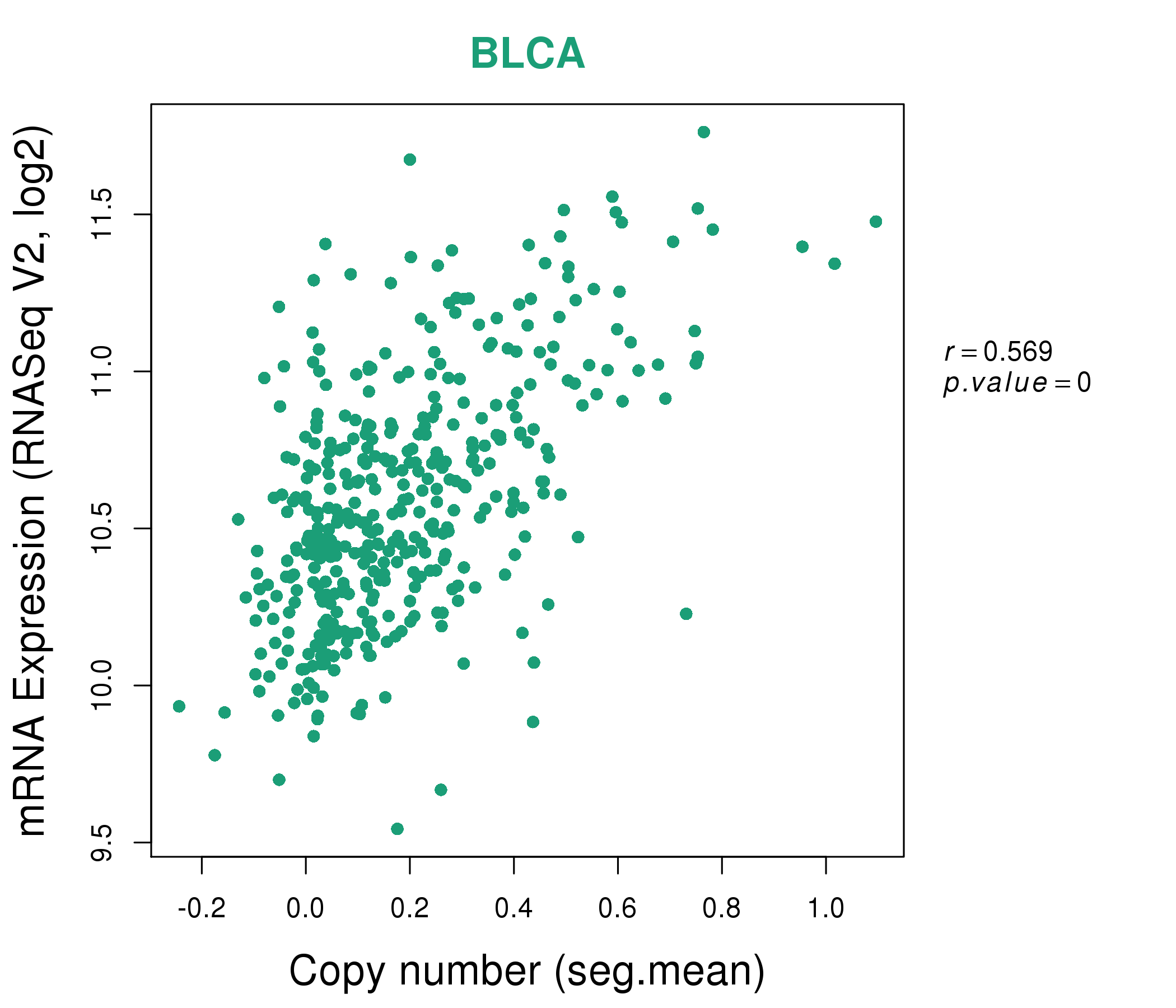 |
|
 |
|
| Top |
| Gene-Gene Network Information |
| * Co-Expression network figures were drawn using R package igraph. Only the top 20 genes with the highest correlations were shown. Red circle: input gene, orange circle: cell metabolism gene, sky circle: other gene |
: Open all plots for all cancer types
 |
| ||||
| ABCF3,ALG3,AP2M1,BDH1,DVL3,EIF2B5,EIF4G1, FXR1,LOC152217,LSG1,MAGEF1,MRPL47,NCBP2,NDUFB5, PARL,POLR2H,PSMD2,RFC4,RPL35A,TMEM41A,WDR53 | APEH,ATPAF2,ATPIF1,C21orf59,CARKD,CNKSR1,DCAF11, EIF2B5,GCAT,GTF2IRD1,KIF22,NPRL2,PDRG1,PPP2R4, PRPF40B,ROGDI,MIEF2,SNAP47,SNRPD3,TMEM186,WRNIP1 | ||||
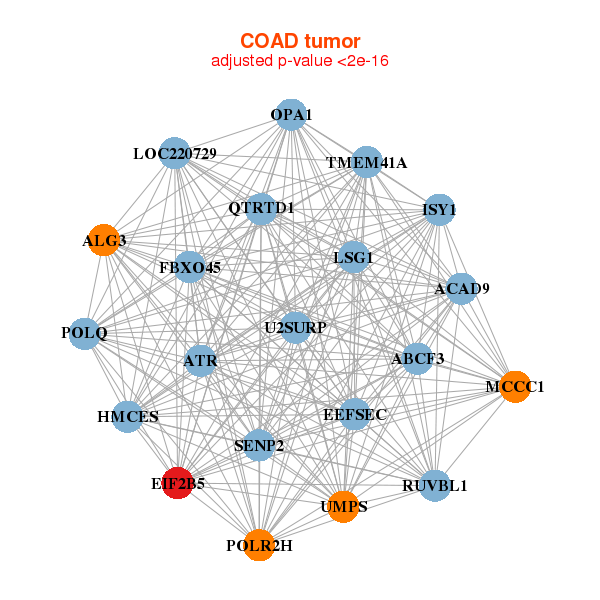 |
| ||||
| ABCF3,ACAD9,ALG3,ATR,HMCES,EEFSEC,EIF2B5, FBXO45,ISY1,LOC220729,LSG1,MCCC1,OPA1,POLQ, POLR2H,QTRTD1,RUVBL1,SENP2,U2SURP,TMEM41A,UMPS | BCL2L12,BIRC5,KNSTRN,C19orf48,MIS18A,ARHGEF39,CCNB1, CDCA4,DNAJC9,EIF2B5,MRPL37,NUP85,PAICS,PRMT5, RANBP1,RCC1,RUVBL1,RUVBL2,SAAL1,NDC1,TRAIP |
| * Co-Expression network figures were drawn using R package igraph. Only the top 20 genes with the highest correlations were shown. Red circle: input gene, orange circle: cell metabolism gene, sky circle: other gene |
: Open all plots for all cancer types
| Top |
: Open all interacting genes' information including KEGG pathway for all interacting genes from DAVID
| Top |
| Pharmacological Information for EIF2B5 |
| DB Category | DB Name | DB's ID and Url link |
| Organism-specific databases | PharmGKB | PA27692; -. |
| Organism-specific databases | CTD | 8893; -. |
| * Gene Centered Interaction Network. |
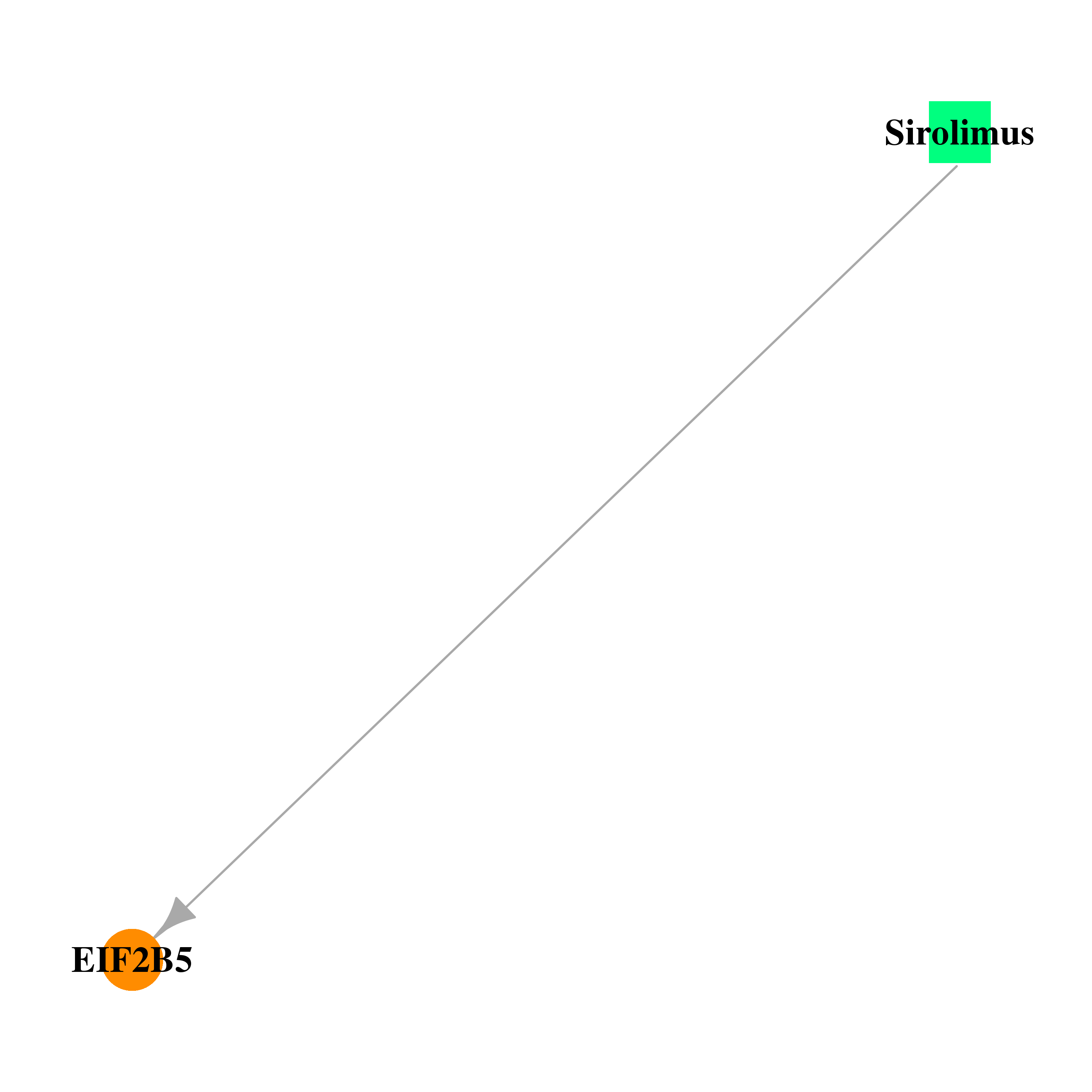 |
| * Drug Centered Interaction Network. |
| DrugBank ID | Target Name | Drug Groups | Generic Name | Drug Centered Network | Drug Structure |
| DB00877 | eukaryotic translation initiation factor 2B, subunit 5 epsilon, 82kDa | approved; investigational | Sirolimus | 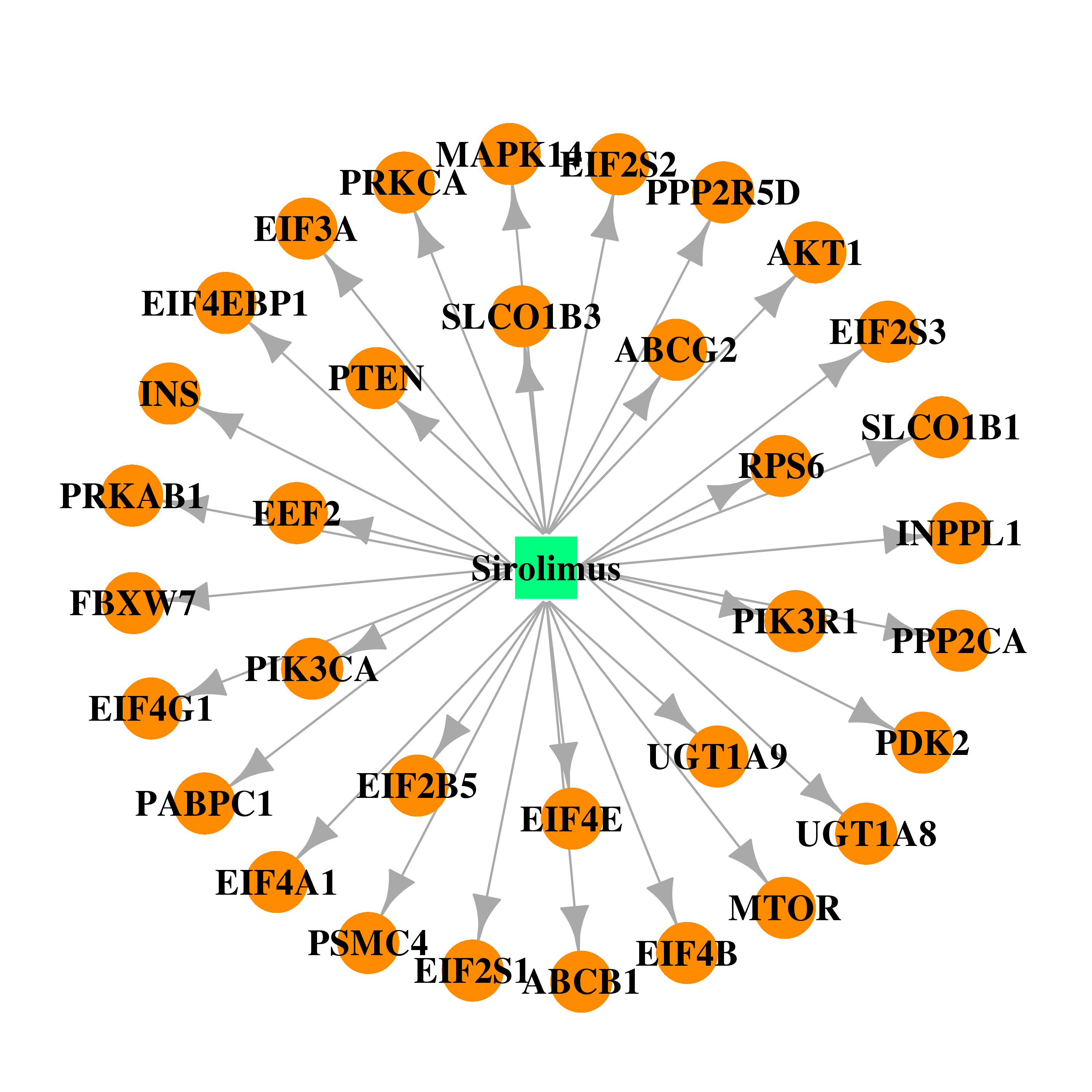 |  |
| Top |
| Cross referenced IDs for EIF2B5 |
| * We obtained these cross-references from Uniprot database. It covers 150 different DBs, 18 categories. http://www.uniprot.org/help/cross_references_section |
: Open all cross reference information
|
Copyright © 2016-Present - The Univsersity of Texas Health Science Center at Houston @ |






